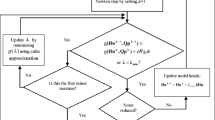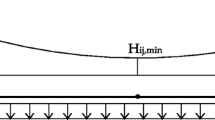Abstract
EPANET 2 has been used previously to simulate pressure-deficient operating conditions in water distribution systems by: (a) executing the algorithm repetitively until convergence is achieved; (b) modifying the source code to cater for pressure-dependent outflows; or (c) incorporating artificial elements e.g., reservoirs in the data input file. This paper describes a modelling approach that enables operating conditions with insufficient pressure to be simulated in a single execution of EPANET 2 without modifying the source code. This is achieved by connecting a check valve, a flow control valve and an emitter to the demand nodes. Thus the modelling approach proposed enhances an earlier formulation by obviating the need for an artificial reservoir at the nodes with insufficient pressure. Consequently the connecting pipe for the artificial reservoir (for which additional data must be provided) is not required. Also, we removed a previous limitation in the modelling of pressure-dependent nodal flows to better reflect the performance of the nodes with insufficient flow and pressure. This yields improved estimates of the available nodal flow and is achieved by simulating pressure-deficient nodal flows with emitters. The emitter discharge equation enables the nodal head-flow relationship to be varied to reflect the characteristics of any network. The procedure lends itself to extended period simulation, especially when carried out with the EPANET toolkit. The merits of the methodology are illustrated on several networks from the literature one of which has 2465 pipes. The results suggest the procedure is robust, reliable and fast enough for regular use.




Similar content being viewed by others
References
Ackley JRL, Tanyimboh TT, Tahar B, Templeman AB (2001) Head-driven analysis of water distribution systems. International Conference on Computing and Control for the Water Industry, Leicester, pp 3–5
Agrawal ML, Gupta R, Bhave PR (2007) Optimal design of level 1 redundant water distribution networks considering nodal storage. J Environ Eng 133(3):319–330
Ang WK, Jowitt PW (2006) Solution for water distribution systems under pressure-deficient conditions. J Water Resour Plann Manag 132(3):175–182
Bhave PR (1981) Node flow analysis of water distribution systems. J Transp Eng 107(4):457–467
Bhave PR (1988) Extended period simulation of water systems—direct solution. J Environ Eng 114(5):1146–1159
Bhave PR, Gupta R (2006) Analysis of water distribution networks. Narosa Pub. House Pvt. Ltd. New Delhi, India; and Alpha Science International Ltd., Pangbourne, UK
Chandapillai J (1991) Realistic simulation of water distribution systems. J Transp Eng 117(2):258–263
Ciaponi C, Franchioli L, Murari E, Papiri S (2015) Procedure for defining a pressure-outflow relationship regarding indoor demands in pressure-driven analysis of water distribution networks. Water Resour Manag 29:817–832. doi:10.1007/s11269-014-0845-2
Creaco E, Franchini M, Alvisi S (2010) Optimal placement of isolation valves in water distribution systems based on valve cost and weighted average demand shortfall. Water Resour Manag 24:4317–4338
Cross H (1936) Analysis of flow in networks of conduits or conductors. Bulletin No. 286. Univ. of Illinois Engineering Experimental Station, Urbana, pp 1–29
Farmani R, Savic DA, Walters GA (2005) Evolutionary multi-objective optimization in water distribution network design. Eng Optim 37(2):167–183
Fujiwara O, Ganesharajah T (1993) Reliability assessment of water supply systems with storage and distribution networks. Water Resour Res 29(8):2917–2924
Fujiwara O, Li J (1998) Reliability analysis of water distribution networks in consideration of equity, redistribution, and pressure dependent demand. Water Resour Res 34(7):1843–1850
Germanopoulos G (1985) A technical note on the inclusion of pressure dependent demand and leakage terms in water supply network models. Civ Eng Syst 2(3):171–179
Giustolisi O, Laucelli D (2011) Water distribution network pressure-driven analysis using the enhanced global gradient algorithm. J Water Resour Plann Manag 137(6):498–510
Giustolisi O, Savic D (2010) Identification of segments and optimal isolation valve system design in water distribution networks. Urban Water 7(1):1–15
Giustolisi O, Savic D, Kapelan Z (2008) Pressure-driven demand and leakage simulation for water distribution networks. J Hydraul Eng 134(5):626–635
Giustolisi O, Berardi L, Laucelli D (2014) Modeling local water storages delivering customer demands in WDN models. J Hydraul Eng 140(1):89–104
Gorev NB, Kodzhespirova IF (2013) Noniterative implementation of pressure-dependent demands using the hydraulic analysis engine of EPANET 2. Water Resour Manag 27(10):3623–3630
Gupta R, Bhave PR (1994) Reliability analysis of water distribution systems. J Environ Eng 120(2):447–460
Gupta R, Bhave PR (1996a) Reliability-based design of water distribution systems. J Environ Eng 122(1):51–54
Gupta R, Bhave PR (1996b) Comparison of methods for predicting deficient network performance. J Water Resour Plann Manag 122(3):214–217
Gupta R, Dhapade S, Ganguli S, Bhave PR (2012) Water quality based reliability analysis of water distribution networks. ISH J Hydraul Eng 18(2):80–89
Isaacs LT, Mills KG (1980) Linear theory methods for pipe network analysis. J Hydraul Div ASCE 106(7):1191–1201
Islam MS, Sadiq R, Rodriguez MJ, Najjaran H, Hoorfar M (2014) Reliability assessment for water supply systems under uncertainties. J Water Resour Plann Manag 140(4):468–479
Jinesh Babu KS, Mohan S (2012) Extended period simulation for pressure-deficient water distribution network. J Comput Civ Eng 26(4):498–505
Jun L, Guoping Y (2013) Iterative methodology of pressure-dependent demand based on EPANET for pressure-deficient water distribution analysis. J Water Resour Plann Manag 139(1):34–44
Kalungi P, Tanyimboh TT (2003) Redundancy model for water distribution systems. Reliab Eng Syst Saf 82(3):275–286
Kovalenko Y, Gorev NB, Kodzhespirova IF, Prokhorov E et al (2014) Convergence of a hydraulic solver with pressure-dependent demands. Water Resour Manag 28:1013–1031
Li PH, Kao JJ (2008) Segment-based vulnerability analysis system for a water distribution network. Civil Eng Environ Syst 25(1):41–58
Liserra T, Maglionico M, Ciriello V, Di Federico V (2014) Evaluation of reliability indicators for WDSWs with demand-driven and pressure-driven models. Water Resour Manag. doi:10.1007/s11269-014-0522-5
Martin DW, Peters G (1963) The application of Newton’s method to network analysis by digital computers. J Inst Water Eng 17(2):115–129
Milan C (2010) Hybrid genetic algorithm and linear programming method for least-cost design of water distribution systems. Water Resour Manag 24(1):1–24
Ozger SS, Mays LW (2003) A semi-pressure-driven approach to reliability assessment of water distribution networks. In: Proceedings of 30th IAHR Congress, Aristoteleio Panepistimio Thessalonikis, Thessaloniki, Greece, 345–352
Rossman LA (2000) EPANET 2 users’ manual. U.S. Environmental Protection Agency, Cincinnati
Rossman LA (2007) Discussion on ‘Solution for water distribution systems under pressure-deficient conditions’ by WK Ang and PW Jowitt. J Water Resour Plann Manag 133(6):566–567
Seyoum AG, Tanyimboh TT (2013) Pressure dependent network water quality modelling. J. Water Management, ICE. doi:10.1680/wama.12.00118
Siew C, Tanyimboh TT (2012a) Pressure-dependent EPANET extension. Water Resour Manag 26(6):1477–1498
Siew C, Tanyimboh TT (2012b) Penalty-free feasibility boundary-convergent multi-objective evolutionary algorithm for the optimization of water distribution systems. Water Resour Manag 26(15):4485–4507. doi:10.1007/s11269-012-0158-2
Siew C, Tanyimboh TT, Seyoum AG (2014) Assessment of penalty-free multi-objective evolutionary optimization approach for the design and rehabilitation of water distribution systems. Water Resour Manag 28:373–389
Suribabu SR, Neelakantan TR (2011) Balancing reservoir based approach for solution to pressure deficient water distribution networks. Int J Civ Struct Eng 2(2):639–647
Tabesh M, Yekta A, Burrows R (2009) An integrated model to evaluate losses in water distribution systems. Water Resour Manag 23(3):477–492
Tabesh M, Jamasb M, Moeini R (2011) Calibration of Water distribution hydraulic models: a comparison between pressure dependent and demand driven analysis. Urban Water 8(2):93–102
Tanyimboh TT, Setiadi Y (2008) Joint layout, pipe size and hydraulic reliability optimization of water distribution systems. Eng Optim 40(8):729–747
Tanyimboh TT, Templeman AB (2010) Seamless pressure-deficient water distribution system model. Proc ICE Water Manag 163(8):389–396
Tanyimboh T, Tabesh M, Gupta R, Bhave P (1997) Discussion and closure: comparison of methods for predicting deficient-network performance. J Water Resour Plann Manage 123(6):369–370. doi:10.1061/(ASCE)0733-9496(1997)123:6(369)
Todini E, Pilati S (1987) A gradient algorithm for the analysis of pipe networks. In: Chun-Hou O, Coulbeck B (eds) Computer applications in water supply: Vol.1-system analysis and simulation. Wiley, London, pp 1–20
Vairagade SA, Abdy Sayyed MAH, Gupta R (2015) Node head flow relationships in skeletonized water distribution networks for predicting performance under deficient conditions. Proc. 17th Water Distribution System Analysis Symposium, World Water and Resour. Congress, Austin, Texas. (Accepted & Scheduled for Oral presentation)
Wagner JM, Shamir U, Marks DH (1988) Water distribution reliability: simulation method. J Water Resour Plann Manage 114(3):276–294
Wood DJ, Charles COA (1972) Hydraulic network analysis using linear theory. J Hydraul Div 98(7):1157–1170
Wu ZY, Wang RH, Walski TM, Yang SY, Bowdler D, Baggett CC (2009) Extended global-gradient algorithm for pressure-dependent water distribution analysis. J Water Resour Plann Manage 135(1):13–22
Author information
Authors and Affiliations
Corresponding author
Rights and permissions
About this article
Cite this article
Abdy Sayyed, M.A.H., Gupta, R. & Tanyimboh, T.T. Noniterative Application of EPANET for Pressure Dependent Modelling Of Water Distribution Systems. Water Resour Manage 29, 3227–3242 (2015). https://doi.org/10.1007/s11269-015-0992-0
Received:
Accepted:
Published:
Issue Date:
DOI: https://doi.org/10.1007/s11269-015-0992-0




